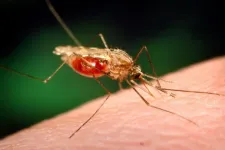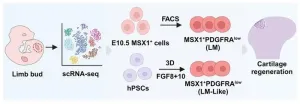Malaria spreads through the bite of Anopheles mosquitoes. While malaria is a disease long associated with lower socioeconomic status, the UVM study links deforestation with higher risk of the disease, particularly for children from poorer households.
“One of the takeaways from this study is in order to have good public health policy it is also important to consider environmental conservation—not degrade the land and make it suitable for breeding mosquitoes,” says lead author Tafesse Estifanos, a former postdoc at UVM’s Gund Institute for Environment.
He partnered with UVM faculty members to analyze the prevalence of malaria in six sub-Saharan African countries where the disease is endemic, including Côte d’Ivoire, the Democratic Republic of the Congo, Guinea, Mozambique, Rwanda, and Togo. The team linked demographic and health survey data of over 11,500 children with mosquito range maps and land-use changes to determine how wealth, temperature, precipitation, and forest cover influenced infection rates. They used multi-level mixed effects models to test potential relationships and found the individuals impacted most are those who can least afford it.
“We have this huge socioeconomic disparity among households,” explains Estifanos.
The data show that the effect of deforestation on malaria prevalence is strongest in less wealthy communities and where certain mosquito species dominate. Malaria was the most prevalent in the poorest households (40.4%) and least prevalent among the richest (6.2%). Residents of poorer households—defined using a composite measure of a household’s living standards such as home ownership, dwelling characteristics, type of drinking water sources, toilet facilities, education, occupation, and income characteristics derived from U.S. Agency for International Development (USAID) Demographic and Health surveys—are also the most likely to live on the fringes of disturbed landscapes that produce favorable breeding conditions for mosquitoes.
The paper continues a decade of UVM research examining relationships between human health and environmental conditions using a massive global database Gund researchers built using USAID’s data from dozens of developing nations. Tafesse, originally from Ethiopia, studied how malaria infections are influenced by land use changes and went one step further by exploring how various mosquito species affects disease transmission.
“By asking where and for whom, Tafesse was able to show that deforestation doesn’t affect everyone’s health the same,” says Gund Director Taylor Ricketts. “Those in poorer communities, and those with certain dominant mosquito vectors, are more vulnerable. That helps us target interventions to have the most benefit for the most vulnerable kids.”
Interventions such as conserving forests. Previous Gund investigations have shown that poorer and more rural communities are often the most affected by ecosystem degradation—and suffer health consequences such as stunting, malnutrition, and diarrheal diseases.
“Conserving forests and other nature is not only good for kids’ health, it does the most good for the most vulnerable kids,” Ricketts says.
Fertile ground for mosquitoes
Humans alter the landscape wherever we live. We raise livestock and crops. We log and level forests and fields for roads, farms, businesses, and homes. These changes not only alter ecosystems but impact the people who live close to animal species and the diseases they transmit—like mosquitoes. This is playing out in sub-Saharan Africa where 94 percent of malaria cases worldwide occur alongside significant land use changes.
Mosquitoes reproduce in standing water found in puddles, buckets, bottles, car tires—even the hoofprints of livestock after it rains, Estifanos explains.
Forests may slow malaria transmission by cooling temperatures and reducing the potential for water to pool, which reduces the amount of time, and the number of places mosquitoes can breed.
And when it comes to malaria, the type of mosquito matters.
“We have non vector mosquitoes, and we have bad mosquitoes, which are vectors of human malaria parasite. Those vectors and human blood feeding ones are the ones creating this issue,” Estifanos says. “The most efficient malaria vectors are found in sub–Saharan Africa and three are the dominant ones: Anopheles gambiae, Anopheles arabiensis and Anopheles funestus.”
Two of these species, Anopheles gambiae and Anopheles funestus, are highly anthropophilic––meaning they prefer to feed on human blood meal. The third type, Anopheles arabiensis, feed on livestock but will use human blood meals in their absence.
The UVM study used spatial data from the Malaria Atlas Project to determine if vector biology and deforestation influence malaria prevalence across landscapes. When the research team disaggregated the data by mosquito species, they found deforestation increased malaria prevalence in regions where the two anthropophilic species are dominant but not where Anopheles arabiensis thrive.
The findings also strengthen the relationship between deforestation and malaria that previous studies have found and underscores the complexity of factors affecting disease transmission—including mosquito species and disturbed environments.
“So often what happens is if a research project is run by an economist or a social scientist, they go deep into the social side—and then oh, there is forest; if it’s run by an ecologist, they go deep on the ecology side and then go—oh, well, wealth,” says study co-author Brendan Fisher, a professor in UVM’s Rubenstein School of Environment and Natural Resources. “Tafesse really drilled down on the complexity, the ecological complexity, and the social complexity, and tried to understand them both.”
Fisher views the sophistication of the study as its strength. The findings add to a growing body of evidence that well-functioning ecosystems benefit humans, particularly the poorest. The benefits of forests are often expressed in economic terms or as a boon to our mental health in western and academic presses, he says. This study shows the benefits of forests in reducing the risk of a deadly infectious disease.
“We are talking about the forest—just doing its own thing—as potentially stemming thousands of deaths a year,” Fisher says. “Yes, forests do a lot of things for us—cycle water, storage carbon and even ease our anxiety, but we have been building up an evidence base showing that children’s lives are directly dependent on a well-functioning forest ecosystem.
“And our analysis here suggests that, once again, conservation, at least as the next step, does seem to benefit those who are least likely to be able to afford alternative health measures—vaccines, bed nets, filtered water, trips to the hospital, antimalarials. All of those benefit a certain set of people whereas forests don’t really care about your wealth.”
Creating healthier landscapes
People living in poverty may be unable to adopt behavioral changes that reduce potential exposure to malaria such as making home improvements or acquiring bed nets. Rural populations face obstacles, too. They often have less access to health facilities that can administer early treatment for malaria.
Climate change poses additional challenges since rising temperatures promote mosquito reproduction. The UVM study found increased temperatures highly associated with malaria prevalence across the region and climate projections for sub-Saharan Africa could make a bad problem worse.
“Previously there were only a few highland areas that were suited for mosquito breeding or for malaria,” Estifanos says. “But these days, because of deforestation and because of climate change, the temperature is rising and [creating more favorable breeding] conditions.”
This means malaria is becoming a common problem in both highland and lowland areas.
“And climate change is not a local issue––it’s a global issue,” Estifanos says.
That’s why he believes health policy needs to encompass factors beyond one person’s control to mitigate malaria transmission. He points to interventions such as scaling up the use of bed net in areas where malaria is endemic.
“It is all about controlling mosquitoes that serve as malaria vectors,” Estifanos explains. “The focus should be on making unfavorable conditions for them to reproduce and survive.”
Keeping forests intact could help.
UVM faculty member Gillian Galford also co-authored the paper. This is the first paper from a larger investigation examining how land use and ecosystem change affect malarial transmission.
###
END





